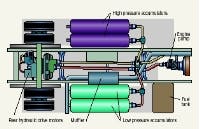Earlier this year, the U.S. Environmental Protection Agency announced a new partnership to show the benefits of its fully hydraulic hybrid technology for urban pick-up and delivery fleets. This unique technology is based on numerous EPA pioneering hybrid patents.
EPA's Ann Arbor, Mich. office and its partner, Eaton Hydraulics, Eden Prairie, Minn., are fabricating the new and innovative integrated hydraulic rear-drive for a United Parcel Service (UPS) package vehicle. Other members contributing to this partnership include: UPS, International Truck and Engine Corp., the U.S. Army's National Automotive Center, and Morgan-Olson.John Kargul, EPA project manager, explains that the vehicle will use what he calls a full series hydraulic system, as opposed to the parallel systems currently available from Eaton and other manufacturers. "Parallel hybrids maintain the mechanical drivetrain that's in the vehicle," says Kargul. "The hydraulics then add power to or take power away from that drivetrain. With a series system, we get rid of the transmission and drivetrain — it's just hydraulics. The engine is now disconnected from the wheels. This allows us to run the engine at the sweet spot, and shut the engine off more readily when it's not needed." Kargul sees series systems as the next generation hybrids.
The hydraulic hybrid technology that will be used in the UPS demonstration vehicle:
- uses a hydraulic energy storage and propulsion system (versus a battery system in electric hybrids)
- captures and stores a large fraction of the energy normally wasted in vehicle braking
- uses this stored energy to help propel the vehicle during subsequent vehicle acceleration, and
- enables the engine to operate more efficiently when it is needed.
The actual demonstration vehicle will include two power sources to operate the vehicle: the EPA's Clean Diesel Combustion engine and hydraulic hybrid components. The primary hydraulic components consist of two hydraulic accumulator vessels, one engine hydraulic pump, and one integrated rear-drive hydraulic motor assembly.
In a minimum state of charge for the hybrid hydraulic system, the high-pressure accumulator has very little fluid in it, and the bulk of the fluid is in the low pressure accumulator. This fluid is what is acted upon by the pump/motor to either add or subtract torque from the vehicle's driveline. This setup is a closed hydraulic system, because the fluid is always pressurized and not exposed to atmospheric conditions. This is in contrast to an open hydraulic system, in which the fluid is at minimum pressure, stored in a reservoir. The reservoir is exposed to atmospheric conditions through a breather.)
The EPA's advanced technology in the UPS demonstration vehicle is targeted to achieve:
- 60-70% better fuel economy
- the 2010 heavy-duty vehicle NOx standard, and
- the ability to recoup additional cost for new hydraulic hybrid technology in less than three years.
The EPA has not released any official date for the demonstration vehicle to be ready, but hopes are that a late 2006 target can be met. Kargul says they plan to provide more information later this year.
EPA is big on hydraulics research
Hydraulic drivetrains are particularly attractive for vehicle applications that entail a significant amount of stop-and-go driving, such as delivery trucks or school buses. A major benefit of a hydraulic hybrid vehicle is the ability to capture and use a large portion of the energy normally lost in vehicle braking. Hydraulic hybrids can quickly and efficiently store and release great amounts of energy due to their high power density. This is a critical factor in maximizing braking energy recovered to increase fuel economy.
Hydraulics can also increase vehicle acceleration performance.-Hydraulic hybrid technology cost-effectivelyallows the engine speed or torque to be independent of vehicle speed, resulting in cleaner and more efficient engine operation.
These systems create a unique opportunity to optimize engine operations. The EPA has produced research concept vehicles that demonstrate the hydraulic technology. One concept vehicle is an urban delivery truck that uses hydraulic "launch assist." This delivery truck retains its conventional-engine and transmission, but adds on a hydraulics package optimized for fuel economy. The next generation of hydraulic vehicles, as described above, involves fully integrating hydraulic technology.
EPA also has achieved major breakthroughs in designing hydraulic accumulators and pump/motors to be more efficient, smaller, and lighter for motor vehicle applications, which will also help improve fuel efficiency.
About the Author

Leaders relevant to this article:



